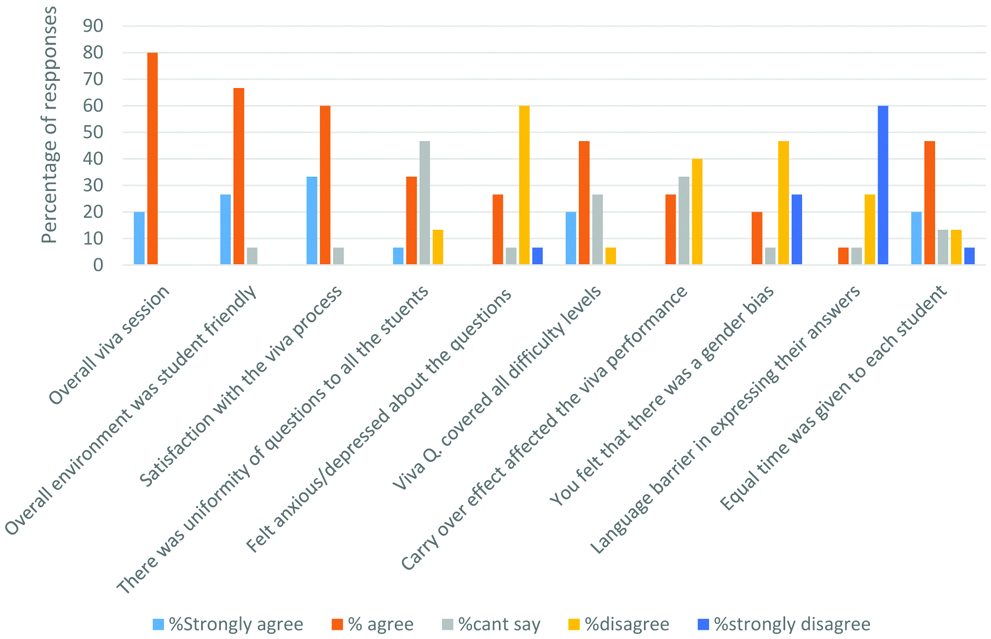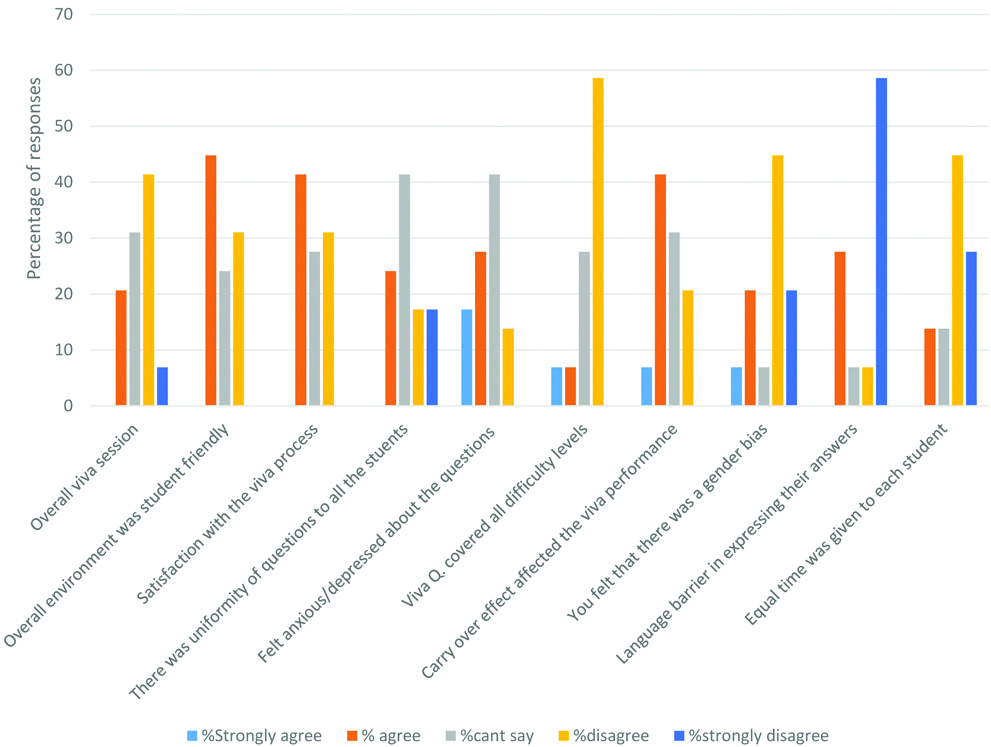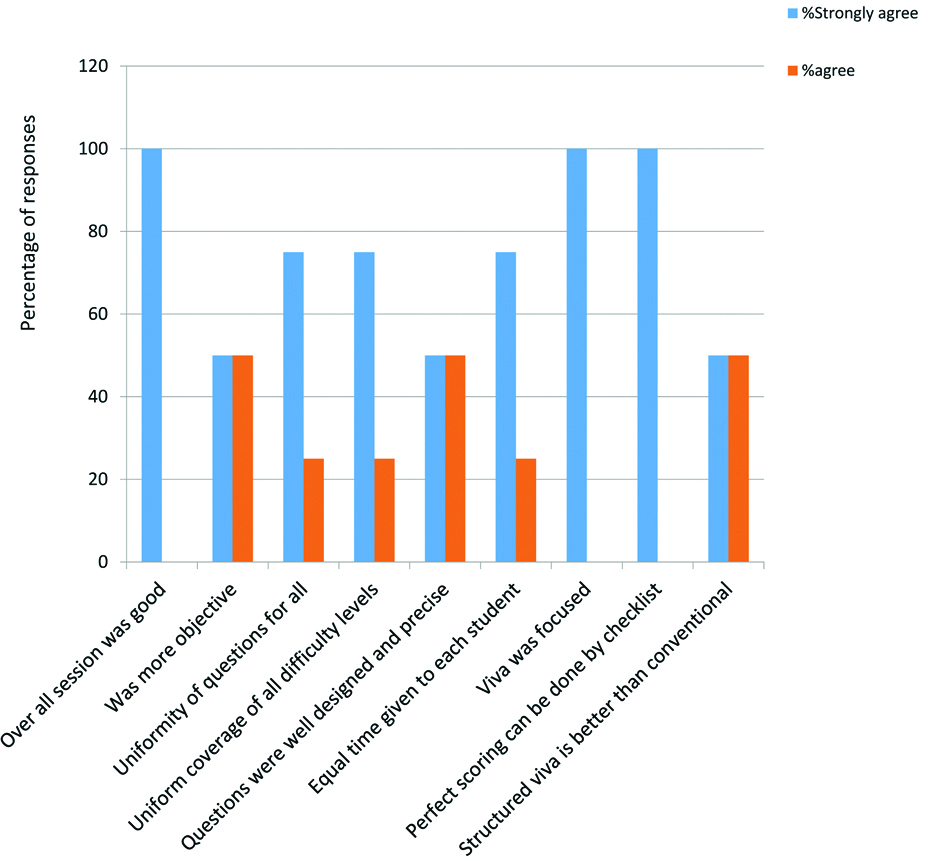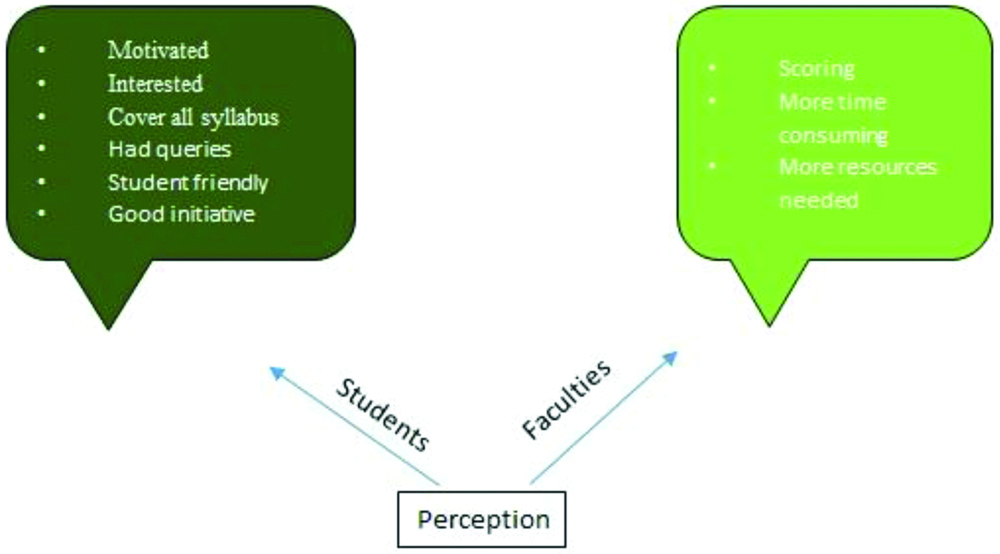Developing and Implementing Structured Viva Voce Examination as a Valid and Reliable Assessment Tool in Biochemistry for First Year BDS Students
Sufia Naseem1, Mehjbeen Javed2, Ummul Baneen3
1 Assistant Professor, Department of Biochemistry, Jawaharlal Nehru Medical College, Aligarh Muslim University, Aligarh, Uttar Pradesh, India.
2 Postdoc, Department of Zoology, Aligarh Muslim University, Aligarh, Uttar Pradesh, India.
3 Assistant Professor, Department of TB and Respiratory Diseases, Jawaharlal Nehru Medical College, Aligarh Muslim University, Aligarh, Uttar Pradesh, India.
NAME, ADDRESS, E-MAIL ID OF THE CORRESPONDING AUTHOR: Dr. Ummul Baneen, G-2, Azim Green Homes, Sir Syed Nagar, Aligarh-202002, Uttar Pradesh, India.
E-mail: ummulb8@gmail.com
Introduction
Traditional viva voce lacks objectivity, reliability and validity. Structured viva voce on the other hand has all these qualities. If introduced from the beginning of the course, it will impart an educational impact to the students.
Aim
To develop structured oral viva voce for BDS first year students. Compare the marks obtained by traditional viva voce examination with the marks obtained by structured viva voce examination. To analyse the perception of students and faculty towards structured viva voce examination.
Materials and Methods
Topic wise structured viva cards were prepared and validated by four subject experts. A total of 29 students were divided into four groups and each group faced the structured as well as traditional viva voce examination. Marks obtained in both the exams were compared. Feedback was taken from students as well from faculty by 5-point Likert scale questionnaires.
Results
The marks scored by students in structured and conventional viva were Group A (n=8) 7.11±0.78, 5.67±0.86 (p=0.0001); Group B (n=7) 7.29±0.75, 5.29±1.12 (p=0.001); Group C (n=7) 8.43±0.53, 7.43±0.53 (p= N.S); Group D (n=7) 8.00±0.89, 6.16 ±1.47 (p=0.002) respectively. The variation in marks ranged from 4 to 8 in conventional and 6 to 9 in structured viva voce. Students and faculty also accepted structured viva voce well.
Conclusion
The structured viva voce is a better assessment tool. Marks scored and student’s feedback was favorable towards Structured Viva Voce and they found it more objective, student friendly and felt more confident. Faculty also appreciated it as a better scoring method.
Introduction
Evaluation is an integral part of assessment of learning in medical colleges. Oral viva-voce examination is an important mode of assessment to test cognitive domain and to some extent attitude, ethics and communication- AETCOM as well [1]. It is aimed to evaluate depth of knowledge, ability to discuss and defend ones’ decision, to test the attitude and alertness and professional competence [2].
Viva voce examinations have more appeal owing to their flexibility and potential to assess aspects of clinical competence as well and it has greater sensitivity and positive and negative predictive values [3]. However, it is not very good at assessing problem solving skills [4]. Since the traditional viva voce question format is not uniform reliability of the viva gets diluted [5]. These can be replaced by improvised version with greater reliability and validity. Silva DV et al., have found considerable reliability in structured, standardised oral examinations [3].
The traditional viva voce examination is more subjective and has been reported to have lesser reliability, objectivity and validity [5]. On contrast, Structured Viva voce is more objective, brings uniformity in the evaluation by oral examination, thereby minimise the chance of subjective bias. Objective Structured Viva Examination (OSVE) was described in 1975, by Harden RM et al., at the Dundee University, for assessment in clinical subjects, which has been a useful tool in evaluation [6].
On the other hand, traditional viva voce examination lack objectivity and holistic approach. So, assessment through traditional viva is moreover subjective. It lacks a structured approach. Evaluation by traditional viva may also involve Examiners Bias and a comprehensive evaluation of all the topics, keeping in mind the difficulty levels is often lacking. In addition to this, in traditional system:
Syllabus is not asked entirely;
All the difficulty levels may not be covered in the questions asked [7];
There may be variation in marking among examiners [8];
Students are not satisfied and often anxious.
However, a structured, more objective and uniform assessment would be possible with structured viva voce. Examiner variations and bias can be minimised to quite an extent. This form of evaluation would be more comprehensive in covering all the topics in relation to their difficulty levels and importance.
Academically good candidates may face situations where there are questions out of context and curriculum and may not perform up to their calibre. This may lead to loss of focus and disinterest in the academic and cause undue stress. This may be seen by their better performance in theory papers as compared to oral exams. Though it is considered to be an effective assessment tool as it can assess the broader area inclusive of knowledge, skills, communication and attitude at the same time. This may become a frightful and demoralising experience because of its weakness in terms of reliability and objectivity. Also, it shows lack of validity in terms of content sampling because of its brief time span of assessment [9,10]. However, to reap its full benefits and avoid technical limitations structured viva voce should include predetermined questions based on the syllabus with well defined objectives rather than random questions personally formulated by examiners on their whims and discretion. This will also promote test and retest reliability thereby minimising bias and serendipity. It will also reduce apprehension and anxiety regarding uncertainties in the viva and provide a comfortable environment.
There could be one limitation of monotony and repetition of questions in the viva especially if there are large number of students. To mitigate these problems it is imperative to create a large database of questions with meticulously adjusted questions including all difficulty levels and a checklist. This will help in maintaining uniformity while avoiding monotony and providing flexibility to examiners.
Therefore, the objectives of the present study was to develop Structured Oral viva voce, comparison of marks obtained by Traditional Viva voce examination with the marks obtained by structured viva voce examination and finally to analyse the perception of students and faculty towards structured viva voce examination.
Materials and Methods
The crossover study was done on first year BDS students at Department of Biochemistry, Jawaharlal Nehru Medical College, Aligarh, Uttar Pradesh, India. Prior this Institutional Ethical Committee approval was taken. The study was carried out from 15th October 2018 to 15th March 2019. Departmental meeting was held for the sensitisation of the colleagues regarding the project. Students were also sensitised regarding the project. Preparation and validation of viva questions and perception questionnaire with the help of subject experts was done. Informed consent was taken from the first year BDS students who were willing to participate in this study. Students were evaluated by both the viva voce examinations and a comparison was made. Study group was 29 students of 1st year BDS. The students who were willing to take up study, gave informed consent and were regular with the course became the part of study. Total students enrolled in BDS are 50 but there were 21 dropouts, so while doing the study the total number of students taken was 29.
Topics for the structured viva voce were decided after discussion with faculties of Biochemistry. Viva Cards on the subject to be examined were prepared and validated by four subject experts. Each viva card for subject examination had a set of seven questions of different difficulty levels, and questions from the topics that a student must know, good to know and nice to know areas were also covered from the syllabus. The students faced the structured as well as traditional viva voce examination with same number of marks in both exams. Comparison of marks scored was done. Feedback questionnaires were prepared and validated by four subject experts along with MEU faculty. The student feedback questionnaire was based on the questionnaire published by Shenwai MR et al., [8].
The study subjects were divided into four groups. Four groups were formed namely A (n=8), B (n=7), C (n=7) and D (n=7). The students were divided into these four groups by picking up chits. Neither the students nor the examiners knew name of the group written inside the chit picked by the students. All four groups were evaluated by both the structured as well as traditional viva voce methods. For the same set of topics, A and B groups were assessed by structured viva while C and D were assessed by traditional viva. Thereafter a cross-over was done and students group A and B gave traditional viva while C and D gave structured viva voce. There were four different examiners for all the four student groups. A comparison in the scoring and variation in scores was done. Perception was taken from both the students and faculty on the same day. Four faculties were considered as examiners for this oral assessment. First examiner took structured viva on Group A and in crossover took structured viva on Group C, second examiner took structured viva on Group B and in crossover took structured viva on Group D, while third examiner took traditional viva of group C and in crossover took traditional viva on Group A and fourth examiner took traditional viva on Group D and in crossover took traditional viva on Group B. Feedback was taken from students as well from faculty by 5-point Likert scale questionnaires (i.e., strongly agree, agree, agree/disagree, disagree and strongly disagree).
Statistical Analysis
Collected data of questionnaires and viva voce marks was recorded in Microsoft excel worksheet and SPSS IBM version 23. The data was collected, tabulated and statistically analysed by applying student’s t-test. The p<0.05 was considered to be statistically significant.
Results
The mean viva voce score for Structured oral viva voce (SOVV) of the four groups were as follows: Group A (7.11), Group B (7.29), Group C (8.43) and Group D (8.00). Likewise, the mean score of Traditional Oral Viva Voce (TOVV) for the Group A, Group B, Group C and Group D were 5.67, 5.29, 7.43 and 6.16, respectively. These results shown in [Table/Fig-1,2 and 3] represents student’s perception of SOVV and TOVV respectively. Analysis of the questionnaire showed a trend in favour for SOVV as against Traditional. Majority of students felt that over all structured viva voce was more convincing and comfortable as compared to traditional. Most students accepted that the environment was more students friendly and anxiety free compared to traditional. The satisfaction with the viva process was also more in SOVV. A 33.33% pupil agreed that there was uniformity of questions that were asked to each student. Whereas disagree percentage was 13.33%. A 20% strongly agreed and 46% agreed that the viva voce covered all the difficulty levels covering all domains, while 26.66% could not comment and 6% did not agree with it. More number of students felt that there was no gender bias and carry over effect. Furthermore, majority opined that equal time was given to each of the students for viva examination and it was easy communication. [Table/Fig-4] shows Faculty’s perception of SOVV. Faculty perception showed that all the faculties were in agreement with the fact that it was a good experience. A 50% of the faculty strongly felt while another 50% agreed that SOVV as more objective. A 75% of the faculty strongly felt that there was uniformity of questions for all and the coverage of all difficulty levels were taken care of. All the faculty unanimously agreed that viva was well focused and perfect scoring could be done. All of them were having same opinion that structured viva voce is better than its traditional counterpart. [Table/Fig-5] has illustration of perception of both students and faculties of SOVV.
Marks scored by structured oral viva voce and traditional oral viva voce.
| Groups | Structured oral viva voce (mean±SD) | Traditional viva voce (mean±SD) | p-value and t-value |
|---|
| Group A (n=8) | 7.11±0.78 | 5.67±0.86 | p=0.0001; t=8.22 |
| Group B (n=7) | 7.29±0.75 | 5.29±1.12 | p=0.001; t=6.481 |
| Group C (n=7) | 8.43±0.53 | 7.43±0.53 | N.S. |
| Group D (n=7) | 8.00±0.89 | 6.16±1.47 | p=0.002; t=5.966 |
Data is given as mean±SD (standard deviation); NS: Not significant; p: Probability; p<0.05 is considered significant
Graphical representation of students’ perception of Structured Oral Viva Voce.

Graphical representation of students’ perception of Traditional Oral Viva Voce.

Graphical representation of faculty (n=4) perception of Structured Oral Viva Voce.

Perceptions of students and faculties of SOVV.

Questions were more scoring as per scoring could be done fright and anxiety was allayed students could perform in a more comfortable and unbiased atmosphere.
Discussion
The viva voce examination is a component of assessment taken up by the medical schools. It is an integral part of assessment owing to its flexibility and scope for testing cognitive skills of higher order as well as skills. Interaction during the viva could be an important in assessing attitude and communication skills as well. However, oral viva voce has its own shortcomings in the form of lesser reliability. Moreover, candidates who have less anxiety tend to score higher in oral exam thereby questioning its validity. The study was aimed to assess the reliability of structured viva voce as a better assessment tool. The results show that the students have scored better in structured viva voce as compared to the traditional viva voce. This is in confirmation with the fact that it allows perfect scoring in a comfortable environment with lack of bias on the part of examiner. The results also showed the perception of the students and teachers in a favourable manner which is supported by more number of responses in the “agree” and “strongly agree” column. Therefore, if the viva voce is taken in a structured manner it will be able to have a reliable assessment of a student’s calibre rather than a performance by chance [11]. Thus, it is suggested that structured viva voce may be greater and valuable tool used for formative assessment and will help students to achieve better results later in the summative assessment. The results of the study are in support of the findings of another study that reported validity and reliability could be increased by using structured oral examinations and also by training the examiners [12]. It is also in confirmation with another study that showed that the students score better in the structured viva voce [13]. Patidar A et al., has concluded that structured oral examinations yield significantly higher marks as compared to traditional oral examinations [14]. A study done by Sharma DB et al., suggested feasibility of conducting structured examination [15]. Analysis done by Vankudre AJ et al., depicted that students were overall satisfied with the structured oral examination and felt it to be better than traditional examination [16]. Faculty also perceived structural oral examination better in uniformity of questions, reducing bias and minimising luck factor [16].
Limitation
One concern of the faculties was that it is time consuming and cumbersome but a study has found that properly planned examinations with structured viva formats have more benefit over the efforts and time spent [8]. Some areas that raised some concerns for future research were effect of examiner training, impact of personal characteristics (disposition, rapport, interest in the subject, communication skills/abilities, and thoughts and beliefs) of both the examiners and examinees on the scores. Another research question leading attention is whether the performance in the oral examinations will be improved with the level of training.
Future Recommendation
Further research is required to justify and support the technique using more number of candidates. Validity and reliability assessment need larger group studies. Viva voce examination is more apt for in depth questioning to discriminate among higher achieving students by assessing advanced cognitive skills.
Conclusion
Structured Viva Voce is a better assessment tool as compared to traditional viva voce as it is more objective, brings uniformity, and prevents bias and variability on the part of examiner. Results and perceptions showed that structured viva voce is a better way of assessment, however a thorough workup is required for pooling standard questions and implementing structured viva voce which will consume time and involve dedicated faculty. It was opined that it allays apprehension and anxiety, gives confidence and improves performance of the student as shown by the marks scored and also the feedback. Both the students and faculties were having favourable opinion that it should be considered for implementation.
Data is given as mean±SD (standard deviation); NS: Not significant; p: Probability; p<0.05 is considered significant
[1]. Khilnani A, Charan J, Thaddanee R, Pathak RR, Makwana S, Khilnani G, Structured oral examination in pharmacology for undergraduate medical students: Factors influencing its implementation Indian J Pharmacol 2015 47(5):546-50.10.4103/0253-7613.16518226600646 [Google Scholar] [CrossRef] [PubMed]
[2]. Moleyar VS, How to conduct medical viva Med J DY Patil Vidyapeeth 2018 11:374-78.10.4103/mjdrdypu.MJDRDYPU_171_17 [Google Scholar] [CrossRef]
[3]. Silva DV, Hanwella R, Ponnamperuma G, The validity of oral assessment (viva) that assesses specific and unique competencies in a postgraduate psychiatry examination SLJ Psychiatry 2012 3(2):16-19.10.4038/sljpsyc.v3i2.5133 [Google Scholar] [CrossRef]
[4]. Guilford JP, Psychometric methods 1954 New YorkMc Graw Hill [Google Scholar]
[5]. Ganji KK, Evaluation of reliability in structured viva voce as a formative assessment of dental students J Dent Educ 2017 81(5):590-96.10.21815/JDE.016.01728461636 [Google Scholar] [CrossRef] [PubMed]
[6]. Harden RM, Stevenson M, Downie WW, Wilson GM, Assessment of clinical competence using objective structured examination Br Med J 1975 1:44710.1136/bmj.1.5955.4471115966 [Google Scholar] [CrossRef] [PubMed]
[7]. Lowry S, Assessment of students BMJ 1993 306(6869):51-54.10.1136/bmj.306.6869.518435583 [Google Scholar] [CrossRef] [PubMed]
[8]. Shenwai MR, Patil KB, Introduction of structured oral examination as a novel assessment tool to first year medical students in physiology J Clin Diagn Res 2013 7(11):2544-47.10.7860/JCDR/2013/7350.360624392396 [Google Scholar] [CrossRef] [PubMed]
[9]. Oakley B, Hencken C, Oral examination assessment practices: Effectiveness and change with first year undergraduate cohort J Hosp Leis Sport Tour Educ 2005 4:3-14.10.3794/johlste.41.88 [Google Scholar] [CrossRef]
[10]. Jayawickramarajah PT, Oral examinations in medical education Med Educ 1985 19(4):290-93.10.1111/j.1365-2923.1985.tb01323.x4021855 [Google Scholar] [CrossRef] [PubMed]
[11]. Schubert A, Tetzlaff JE, Tan M, Ryckman JV, Mascha E, et al, Consistency, interrater reliability, and validity of 441 consecutive mock oral examinations in anesthesiology: implications for use as a tool for assessment of residents Anesthesiology 1999 91(1):288-98.10.1097/00000542-199907000-0003710422954 [Google Scholar] [CrossRef] [PubMed]
[12]. Jacobsohn E, Klock PA, Avidan M, Poor interrater reliability on mock anesthesia oral examinations Can J Anaesth 2006 53(7):659-68.10.1007/BF0302162416803913 [Google Scholar] [CrossRef] [PubMed]
[13]. Shaikh ST, Objective structured viva examination versus traditional viva examination in evaluation of medical students Anat Physiol 2015 5:17510.4172/2161-0940.1000175 [Google Scholar] [CrossRef]
[14]. Patidar A, Chaturvedi JN, Introduction of structured oral examination in formative assessment of pharmacology for 2nd professional MBBS students International Journal of Basic and Clinical Pharmacology 2019 8(2):253-58.10.18203/2319-2003.ijbcp20190143 [Google Scholar] [CrossRef]
[15]. Sharma DB, Saxena K, Gupta V, Shah U, Singh US, Feasibility study of conducting and evaluating a structured oral examination among undergraduate medical students in community medicine Int J Med Sci Public Health 2018 7(7):549-54.10.5455/ijmsph.2018.0308606042018 [Google Scholar] [CrossRef]
[16]. Vankudre AJ, Almale BD, Patil MS, Patil AM, Structured oral examination as an assessment tool for third year Indian MBBS undergraduates in community medicine MVP Journal of Medical Sciences 2016 3(1):33-36.10.18311/mvpjms/2016/v3/i1/687 [Google Scholar] [CrossRef]